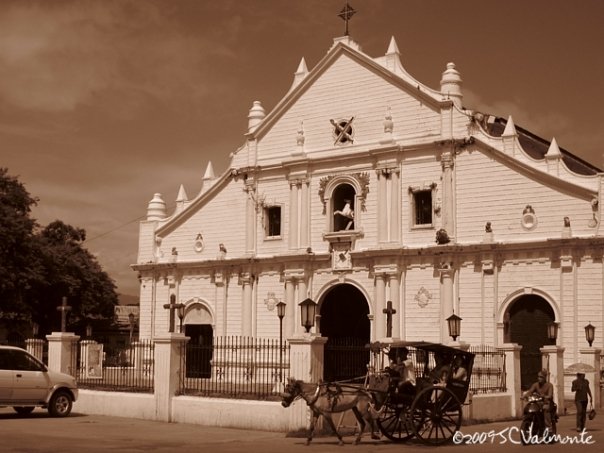FORT SANTIAGO
this was my first visit, and because I have walked on its roads so many times, I kinda felt as if I have already taken all the pictures I wanted. We arrived in Manila at around lunch time. My friends and I ate at Jollibee first, and me saying that I will visit the Manila Metropolitan Cathedral.
Our first stop was the awe-inspiring Manila Metropolitan Cathedral. Also known as the Our Lady of the Immaculate Conception Church, the cathedral was elevated to the rank of minor basilica by virtue of a Papal decree in the early 1980s. Throughout its 400-year history, the church underwent many reconstructions after it was destroyed by natural disasters, bombings and fires.
At this point.... I was thinking.... How did Spaniards colonized Philippines?
The Spanish Era (1565 - 1898)
The Philippine Islands first came to the attention of Europeans when Portuguese explorer Ferdinand Magellan landed there in 1521, claiming the lands for Spain. He was defeated by Lapu-Lapu, a native chieftain, at the Battle of Mactan, where he died. However, his ships reached the Spice Islands. The navigational charts of one of the ships, the Victoria, which circumnavigated the globe, were delivered to Seville in 1522. In 1529, by the treaty of Zaragosa, Spain relinquished all claims to the Spice Islands (and westward) to Portugal. This treaty did not stop subsequent colonization.
Subsequent expeditions expanded Mexican and Spanish influence in the islands. In 1543, Ruy López de Villalobos named the territory Las Islas Filipinas after Philip II of Spain. On April 27, 1565, the first permanent Spanish settlement was founded by Miguel López de Legaspi, with five Augustinian friars, and 400 armed men, on Cebu, which became the town of San Miguel.
Manila
In 1570 the native city of Manila was conquered and declared a Spanish city the following year. When Legazpi decided to transfer his capital to Manila, Cebu receded into the backwaters as influence and power shifted north to Luzon and its wide expanse of fertile lands. The Spanish gradually took control of the islands, which became their outpost in Asia.
Spanish colonial rule
Spanish colonial rule brought Catholicism. One friar, Fr. Juan de Placencia wrote a Spanish-to-Tagalog Christian Doctrine 1593 which transliterated from Roman characters to Tagalog Baybayin characters; since most of the population of Manila could read and write Baybayin at one time, this effort probably helped the conversion to Christianity.
Most of the islands, with the exception of Mindanao, which remained primarily Muslim, were converted. Muslims resisted the attempts of the Spanish to conquer the archipelago and this resulted in a lot of tension and violence, which persists to the modern era.
The Universidad de Santo Tomas, the oldest educational institution, was opened in 1611.
The colonial period also saw the Spanish dominate the economy, focusing on tobacco, as well as the Galleon Trade between Manila and Acapulco, Mexico. To avoid hostile powers, most trade between Spain and the Philippines was via the Pacific Ocean to Mexico (Manila to Acapulco) and then across the Caribbean Sea and Atlantic Ocean to Spain (Veracruz to Cádiz).
From 1521 to 1781, the Philippines were administered as a colony of New Spain (Mexico). During Spain’s almost 350 years rule of the Philippines, there were more priests and missionaries rather than soldiers or civil servants in the country. The Spanish military had to fight off Chinese pirates (who sometimes came to lay siege to Manila), Dutch forces, Portuguese forces, and insurgent natives. In the late 16th century, the Japanese, under Hideyoshi, claimed control of the islands and for a time the Spanish paid tribute to secure their trading routes and protect Jesuit missionaries in Japan. In 1762, the British East India Company seized Manila with a force of 13 ships and 6830 men, easily taking the Spanish garrison of 600, but made little effort to extend their control beyond the port city. By 1764 the Treaty of Paris (1763) had returned Manila to Spain.
A Spanish province (1821-1896)
The Spanish Government took full control of the archipelago in 1821 when Mexico declared their independence.
Commerce was tightly controlled by Spanish authorities until 1837 when Manila was made an open port. In 1863, Queen Isabel II of Spain decreed the establishment of the public school system. Developments in and out of the country and the opening up of the Suez Canal in 1869, which helped cut travel time to Spain, brought new ideas to the Philippines. This prompted the rise of the illustrados, or the Filipino upper middle class. Many young Filipinos were thus able to study in Europe.
Gomburza and the Colonial Church
Although many Spanish friars protested abuses by the Spanish government and military they themselves commited many indescressions and had utilized the government for their own means. Many Filipinos were enraged when Friars blocked the ascent of highly trained Filipino clergy in the Catholic Church hierarchy.
Vast lands were claimed as friar estates from landless farmers. There were also sexual abuses. 'Anak ni Padre Damaso'(Child of Father Damaso) has become a cliche to refer to an illegitimate child, especially that of a priest. The matyrdom of Fr. Jose Burgos, Fr. Zammora, and Fr. Gomez further aggravated mass discontent and is said to indirectly have ignited the Philippine revolution and had a profound effect on Dr. Jose Rizal. It was in the light of these abuses that the Philippine Independent Church was born.
|




